#193: Stropharia rugosoannulata, The Wine Cap
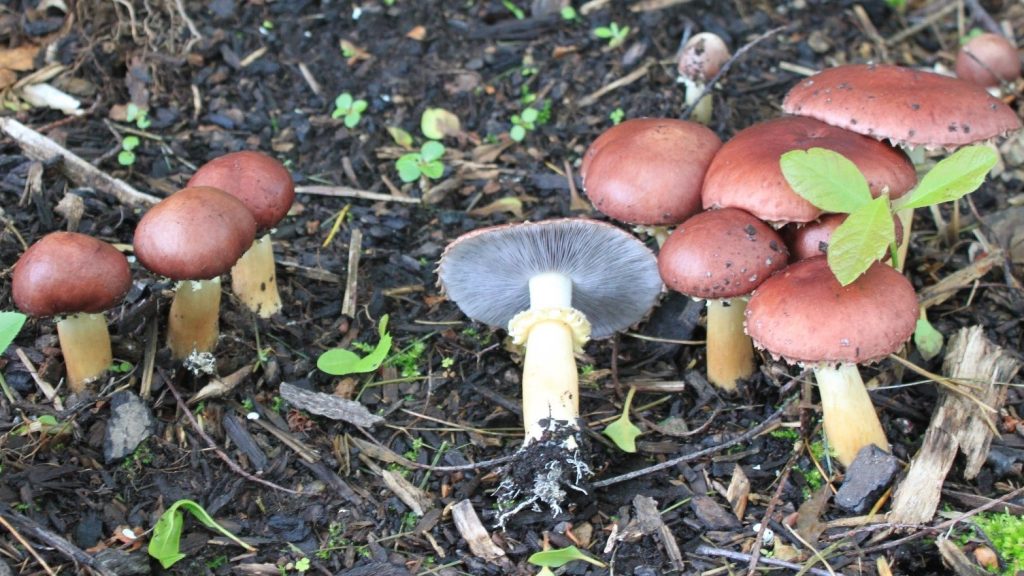
Stropharia rugosoannulata grows almost exclusively in mulch and similar artificial habitats. When young, it has a distinctive wine-red cap. Photo by Ann B. at Mushroom Observer [CC BY-SA 3.0], via Wikimedia Commons
Description
S. rugosoannulata is a medium to large umbrella-shaped agaric. Like most of its relatives, it has a circular pileus and a central stipe. The mushrooms grow 8-20cm tall and 4-15cm wide, but can get much bigger; the larger specimens can weigh three pounds or more! Other than that, S. rugosoannulata is typical of its genus.1–4
The most distinctive feature of the Wine Cap is its pileus, which is a deep shade of red reminiscent of red wine. Other than that distinctive color, the cap is boring; it is smooth, starts out convex, and ends almost flat. Unfortunately, the cap’s wine-red color fades as the mushroom ages. By the time it is fully grown, the cap is light brown to whitish. Sometimes, partial veil material sticks to the edge of the pileus. This material is thin and not very noticeable until it gets colored by the mushroom’s dark spores.1–4
Underneath the pileus, S. rugosoannulata produces attached gills that start grayish but become blackish purple as the spores mature.1–4 The gills deposit a purple-black spore print. These features are standard for Stropharia species and can help you identify the mushroom’s genus.
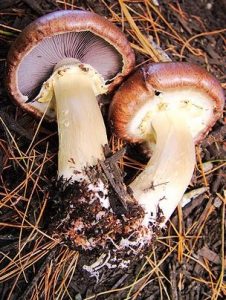
The Wine Cap has a distinctive cogwheeled partial veil. This simplifies identification, as long as the veil hasn’t fallen off! Photo by apa3 [CC BY 2.0], via Wikimedia Commons
Inside the mushroom, the Wine Cap produces firm white tissue that has no distinctive scent or flavor. The flesh does not change color when injured and is therefore not very useful for identification purposes.1–4
Ecology
The Wine Cap is primarily found in mulch beds, gardens, and similar artificial habitats.1–4 Where it appears in the wild, you usually find it where mulch has washed down and collected with sticks and other plant debris.1 These areas, often along stream beds, are nature’s equivalent of mulch piles. In central Europe, there are areas where the fungus has adapted enough to the environment that it is regularly found growing in the wild. S. rugosoannulata has a worldwide distribution, thanks to plant imports. It is now possible to find the Wine Cap almost everywhere that mulch and similar plant products are used. Because of this human-mediated distribution, mycologists do not know where the fungus came from originally.3 It was first described from America in 1922,4 but it seems likely that S. rugosoannulata already had a global distribution at that point. Wine Caps appear any time the conditions are right from spring through fall.1,2,4
Similar Species
A very large umbrella-shaped brown mushroom growing in mulch? It’s probably S. rogosoannulata. Small mushrooms growing in mulch with dark red caps? They’re most likely Wine Caps. A medium-sized brownish mushroom growing in mulch… that’s a bit trickier; there are many mushrooms which fit that description. If you find a mushroom like that, take a spore print to help narrow down your options. Agrocybe spp., for example, produce a medium brown spore print,5 which helps distinguish them. Even if you get a dark brown spore print, you will still have to use a field guide to separate out all the similar stropharioid mushrooms.
Edibility and Uses
The Wine Cap is considered edible, and some even say it is choice.2,4 This is good news for mushroom hunters, since S. rugosoannulata frequently fruits in abundance and you often find more mushrooms than you can eat. On top of that, some people are probably happy that you want to get rid of the mushrooms in their garden.
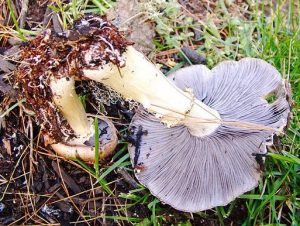
The Wine Cap is a good edible when fresh. However, it soon gets buggy, making older specimens unappetizing. Photo by apa3a [CC BY 2.0], via Wikimedia Commons
S. rugosoannulata is also used for its ability to release nutrients into the soil. In Europe, it was widely used to help break down mulch and thereby support the growth of corn crops.3 So, even if you don’t like the mushrooms in your garden, they are actually beneficial to your plants!
Taxonomy
Although the King Stropharia’s name is officially S. rugosoannulata, various authors spell it S. rugoso-annulata or S. rugoso annulata. The mushroom also has many common names, which is not surprising given the Wine Cap’s widespread distribution. In addition to variants on “Wine Cap,” S. rugosoannulata sometimes bears the names “Burgundy Mushroom,” “Garden Giant,” and “Wine Roundhead” (British).2–4,7
| Kingdom | Fungi |
| Division (Phylum) | Basidiomycota |
| Subdivision (Subphylum) | Agaricomycotina |
| Class | Agaricomycetes |
| Subclass | Agaricomycetidae |
| Order | Agaricales |
| Family | Strophariaceae |
| Genus | Stropharia |
| Species | Stropharia rugosoannulata Farl. ex Murrill8 |
This post does not contain enough information to positively identify any mushroom. When collecting for the table, always use a local field guide to identify your mushrooms down to species. If you need a quality, free field guide to North American mushrooms, I recommend Michael Kuo’s MushroomExpert.com. Remember: when in doubt, throw it out!
See Further:
http://www.mushroomexpert.com/stropharia_rugosoannulata.html
http://www.first-nature.com/fungi/stropharia-rugosoannulata.php
Citations
- Kuo, M. Stropharia rugosoannulata. MushroomExpert.Com (2016). Available at: http://www.mushroomexpert.com/stropharia_rugosoannulata.html. (Accessed: 30th June 2017)
- Emberger, G. Stropharia rugosoannulata. Fungi Growing on Wood (2008). Available at: http://www.messiah.edu/oakes/fungi_on_wood/gilled%20fungi/species%20pages/Stropharia%20rugosoannulata.htm. (Accessed: 30th June 2017)
- Stamets, P. Mycelium Running: How Mushrooms Can Help Save the World. (Potter/TenSpeed/Harmony, 2011).
- O’Reilly, P. Stropharia rugosoannulata Farl. ex Murrill – Wine Roundhead. First Nature Available at: http://www.first-nature.com/fungi/stropharia-rugosoannulata.php. (Accessed: 30th June 2017)
- Kuo, M. The Genus Agrocybe. MushroomExpert.Com Available at: http://www.mushroomexpert.com/agrocybe.html. (Accessed: 30th June 2017)
- Cultivation of wine-cap stropharia. Unicorn Bags Available at: http://unicornbags.com/cultivation/stru.shtml. (Accessed: 30th June 2017)
- Stropharia rugosoannulata. Wikipedia (2016).
- Stropharia rugosoannulata. Mycobank Available at: http://www.mycobank.org/Biolomics.aspx?Table=Mycobank&Rec=26574&Fields=All. (Accessed: 30th June 2017)

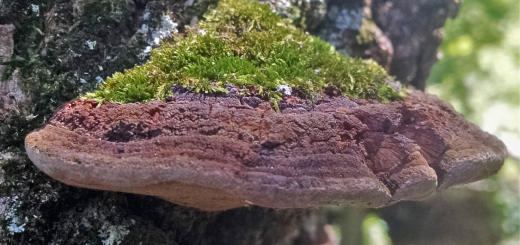






![#011: Characteristics of Kingdom Fungi [Archived]](https://www.fungusfactfriday.com/wp-content/themes/hueman/assets/front/img/thumb-small-empty.png)

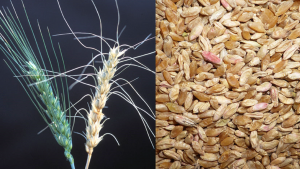
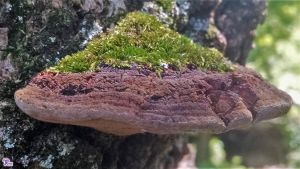
2 Responses
[…] very few edible stropharioid mushrooms. The best edible in the group is Stropharia rugosoannulata (FFF#193), known as the Wine Cap or King Stropharia, and is actually cultivated in Europe. Hypholoma […]
[…] less common than the other mulch-associated mushrooms like stinkhorns (FFF#190) and Wine Caps (FFF#193). The fact that the mushroom hasn’t been recorded from the Rocky Mountains or most of the […]